|
MEDIA RELEASE Sunday 16 June 2024 Position Statement
Neither ASH, nor any representative of ASH, has ever;
Margaret Moorhouse President, Alliance to Save Hinchinbrook Inc.
NOTES The cardinal principle for managing national parks is to provide, to the greatest possible extent, for the permanent preservation of the area's natural condition and the protection of the area's cultural resources and values.5 July 2022 (Parks and forests - Queensland National Parks) see also https://www.abc.net.au/news/2019-02-19/hinchinbrook-island-cape-richards-lease-changes/10821934 see also www.hinchinbrook.com Margaret J Moorhouse President Alliance to Save Hinchinbrook Inc.
0 Comments
Hinchinbrook Island National Park seems to have survived the threat of long-term leases, mass walking parties, infrastructure (pack-less day-walk Taj Majal “glamping”, roads for suitcase-trucking, accommodation supplies, helicopter pads etc). Hinchinbrook Island National Park is now LEASE-FREE - something the Queensland government had told us, for more than 20 years, could not be done. Thank you - to all the defenders of Hinchinbrook Island, including Cardwell residents and businesses, permit holders, local and far-away conservationists and self-reliant wilderness walkers, past Hinchinbrook Campaign activists, members of ASH (including overseas); and particularly to the Island’s Banjin people and their determined and absolute opposition to commercial leasing of their traditional country. The irony is that the government terminated the old Cape Richards lease to make way (business-wise) for the proposed new Brett Godfrey lease over the 5-day Thorsborne Wilderness Trail. The notice of invitation for Expressions of Interest (EOI) for commercial leasing of the Thorsborne Trail was published in October 2018. I’m informed that news of it reached Margaret Thorsborne, who was in nursing care in Cardwell, awaiting the end of her life. I’m convinced she knew exactly what to do: she chose that moment to leave us: October 16th 2018. No need to organise a campaign – people came from everywhere to Margaret’s funeral in Cardwell, to honour her life and stand up for her greatest cause – the restoration of Hinchinbrook Island to its natural state. Arthur and Margaret Thorsborne, Friends of Hinchinbrook, Alliance to Save Hinchinbrook – we’ve all been working towards restoring Hinchinbrook Island to its pre-European condition (lease, gazetted road, esplanade, buildings, coconut plantation – and there’s still a bit to go). An arrogant Queensland government had not bothered to investigate what opposition they might encounter to the commercialisation of Hinchinbrook Island, never mind consider the people with close ties to the Island and the Thorsbornes, or protective of the public interest – not even the traditional owners. It proved to be the end of Minister Kate Jones’ political career - she who’d said “the Nature Conservation Act allows it” (ABC) – knowing full well her government had repeatedly reneged on a repeated election promise that they would reverse the Newman government amendment that had turned the Nature Conservation Act into an instrument for private development. THE THORSBORNE FAMILY HAS MADE A SPECIAL REQUEST On the basis that Hinchinbrook Island is
ASH strongly supports this request. We encourage others to do the same. BACKGROUND Queensland’s national park story 110 years ago, some extraordinarily far-sighted citizens saw the value, for the unknown people of the future, in setting aside as a public good, tracts of land that had outstanding landscapes and biodiversity. A major influence was grazier Robert Collins, who had been inspired by a visit to Yellowstone National Park (USA). By the 1920s these inspired people were led by Romeo Lahey and Arthur Groom; assisted by my late uncles Wallace, Malcolm and Allen Clelland (who in 1930 established the National Parks Association of Queensland), and others. The Binnaburra site was surveyed by my late father, Oswald Moorhouse Higginbottom and Romeo Lahey. These early leaders of the NPAQ were instrumental in exploring “the bush” to locate those most special areas deserving of national park declaration. By the early 1930s some 30 national parks had been gazetted covering 63,330 hectares. Campaigning continued through the 1930s for Mt Barney, Mt Lindesay, Bellenden Kerr, Chillagoe caves, Cunningham's Gap, Dunk Island, Eungella, Hinchinbrook Island and all unalienated islands off the Queensland coast. Hinchinbrook Island was gazetted and dedicated in 1932 and 1934; and later listed on the National Heritage Register, along with the Hinchinbrook Passage. The National Heritage Register was abolished in 2012. To get the 1996 Commonwealth approval for the Keith Williams “Port Hinchinbrook” canal estate, the Queensland Borbidge government signed an agreement to write detailed world-heritage-protective coastal legislation. Presaged by strong interim arrangements, this very effective “no-adverse-impact” catchment-based legislation was enacted in 2003; and abolished by Queensland Premier Anna Bligh on 05 February 2012 – just before the state election that brought in the Newman Government. From the moment it was elected (2015), the Palaszczuc government spread the myth that the Newman government was responsible for every assault on the natural environment, including the loss of the coastal legislation that was actually abolished by Premier Anna Bligh and Minister Kate Jones. Even now, in 2021, a new environment minister had to be disabused of this disinformation.
National Park management and the Nature Conservation Act The original object of the Nature Conservation Act (Queensland) (NCA) (gazetted 1992) was “conservation of nature” - known as the Cardinal Principle of national park management (see below). In 2014 the Newman Government removed the Cardinal Principle from the NCA. Hansard reveals that the Labor Party, in opposition, strongly opposed this amendment and promised to reverse it. Next, they made an election commitment to restore the Act to its original wording. Nevertheless, every incoming Palaszczuk government repeatedly refused to restore the Cardinal Principle to the Nature Conservation Act. Although they amended the Newman Object clause to remove the business purpose he’d added, the Palaszczuk government refused repeatedly to delete the other Newman clauses that allow the Object clause to be bypassed; allowing the Palaszczuk government to hand national parks over to private business interests via 60-year leases. The legal and practical effect of long term leasing is to sell the use rights of the land leased. As pointed out in the Romeo Lahey Lectures including by Allen Clelland (NPAQ newsletter 1970): although bushwalking is a fine activity, the purpose of national parks is for the preservation of nature. This became the Cardinal Principle, still formally stated on the QPWS website:
The first Hinchinbrook Island National Park management Plan (HINPMP) took 13 years of requests from Margaret and Arthur Thorsborne. The first draft for consultation was released in 1991. The final was released in 1999, not by the Minister of the day but by North Queensland Conservation Council (NQCC), after “someone” had anonymously delivered to the NQCC office a brown paper bundle containing the finalised and formally signed-off printed and bound official booklets. The withholding of the official release of this first HINPMP had occurred during the time that Keith Williams was trying to sell his acid sulphate soil blocks opposite Hinchinbrook Island on the promise of easy commercial boating access to the national park. Fast forward 2012-2015: During 2012-2014 the Newman government let loose terrible destruction in Queensland. They made multiple legislative amendments to trash the natural environment. With no Upper House to curb their excesses, the state of Queensland, one of the richest biodiversity hot spots on the planet was brought low. We saw:
Cattle in national parks! Removal of land clearing restrictions! Abolition of the Cardinal Principle of national park management! 2014: The Labor Party made pre-election commitments to re-amend the legislation to its original wording. 2015: In office, the newly-elected Palaszczuk government reneged on their promise. The Palaszczuk government did not restore the Cardinal Principle in the Nature Conservation Act - while claiming loudly they had done so. Instead, they retained certain Newman amendments precisely to negate the Cardinal Principle and to facilitate business in national parks, confirmed publicly by then Innovation Minister Kate Jones (ABC TV). The Palaszczuc government used the rewritten Nature Conservation Act to trash the national park concept and hand over this public good for private business and recreational sports. There followed rapid invasion of national parks by sporting activities such as mountain biking, in frank negation of the Cardinal Principle. QPWS Rangers are now little more than yard workers to clean up the impacts of commercial activities. Two terms of the Palaszczuk government have shown that Queensland Environment Ministers no longer stand up for their portfolios. The Ministerial arrangements forbid ministers to express opinion or make any commitment without the Premier’s permission. ESD and the Precautionary Principle: Further, from the Bligh government on, every Queensland Government has confirmed it will NOT apply Ecologically Sustainable Development (ESD) or the related Precautionary Principle; despite Queensland’s signature on the 1992 Intergovernmental Agreement on the Environment (IGAE). 2018 - DITID – Department of Ignorance … The ignorance of DITID (Queensland Department of Innovation Tourism and Industry Development) is such that (in its 2018 EOI advertisement) it insulted the world-famous Thorsborne Trail as “rudimentary” – as if a wilderness trail specified for self-reliant walkers should be blazoned across the landscape. Demonstrating utter disrespect for UNESCO, the World Heritage Convention, and the world heritage area Operational Guidelines, DITID reinterpreted the UNESCO term Presentation. Presentation is a world heritage duty secondary to Conservation (which includes Rehabilitation) – the UNESCO definition is appreciation of the Area for its intrinsic values – and that means, NOT for instrumental uses, NOT for extrinsic reward, NOT trashing the people’s place of natural beauty and solitude for cash, and NOT for mountain-biking and other competitive and ground-destroying sports. Despite Hinchinbrook Island’s international renown for natural beauty and remoteness, DITID was detremined to trample the Island’s world heritage values; particularly aesthetic value (natural beauty) and wilderness value (remote solitude in nature). Unlike use values, Wilderness and Aesthetic values cannot be “managed”; they must be protected. “managing use” (in this context) always means “minimising” and “mitigating” damage. Wilderness and Aesthetic values are the best protection the Island can have for its rich biodiversity and bio-abundance. 2021 Queensland Government double-speak: See box below - Queensland Department of Environment and Science (DES) web page 27 December 2021. Para 1 states the Cardinal Principle of national park management. Para 2 describes “other management principles” – as if these could be compatible with the cardinal principle. The two dot points (para 2) are, however, entirely incompatible with the Cardinal Principle of national park management. To put it another way: if the Queensland government actually intended to implement the Cardinal Principle, they’d have made no reference to the lesser principle of “ecologically sustainable” use, (Ecologically Sustainable Development (ESD)) supposedly applied in the nature-destructive context of development proposals and openly eschewed by every Queensland government since 2011. Nick Dametto MP, CCRC councilors, the Scotts, Marina News, real estate agents, assorted scammers, speculators and PH block-owners … WHY are they tied to the false place name ONE MILE CREEK? Their common interest is in getting the state and Commonwealth governments to pay for the dredging of a private waterway so they can all benefit– whether in votes or dollars. They all want a few years during which more blocks and berths can be sold, on the basis of the lie of “deep water access” … just like Keith Williams! They want “normalising” Port Hinchinbrook to be a property boom– just listen to your own councilors at the last CCRC meeting. AND we’ll all get rich – the same cargo-cult mentality that sucked Cardwell into this maelstrom in the 1990s. And after five years? - and if no cyclone can be blamed for the naturally infilled waterways or otherwise used to rob the public purse?- then – it will start all over again. And again. Driven by election cycles. MEET THE PLAYERS 1. The present development company: The Passage Holdings P/L (ACN 602422891) liquidation commenced 17/07/2017 by plaintiff Jason John Scott & Ors. 2. not to be confused with Passage Holdings (Qld) P/L (ACN 146 455 138), contact person Clive Scott (Connolly Suthers solicitors Townsville). 3. Gary Scott, Clive Scott, block owners and associated property promoters. 4. Real estate agents eg Cardwell local Lindsay Hallam. 5. Nick Dametto MP (Hinchinbrook) who, in using the false place name ONE MILE CREEK, avoided alerting the public to the officially documented infeasibility of dredging the “Port Hinchinbrook” access canal (Stony Creek). Dametto is using the same false name for the Port Hinchinbrook access canal as Marina News: Dametto’s sign at the Port Hinchinbrook Boat Ramp, and in recent “Marina News”
7. CCRC – also using the false place name ONE MILE CREEK, thus avoiding reference to “Port Hinchinbrook”, Stony Creek and the 1996 Deed of Agreement when obtaining promises of money from the Commonwealth government, ALL the councilors and staff advised about the provisions of the Deed. 8. Queensland DES – which gave a dredging licence (since suspended) under the false place name One Mile Creek. DES is correcting their records. Des also says licencing process is unrelated to who pays. 9. DNRME (now Resources Dept) which didn’t notice an unauthorised change in the official Queensland Place Name Gazetteer (the legal bible of place names, boundaries etc). When so advised in December 2019, DNRME said they’d correct the official record at once. Maybe they did. But the public Queensland Globe mapping program was not corrected until after DNRME had been contacted by the Queensland Crime and Corruption Commission (CCC). Even then it was a year before they corrected it in every layer.  10. Queensland Government – represented by Deputy Premier Steven Miles. The state government does not want to pay for its 1994 contribution to this debacle. Minister Miles, who won’t call in a development that threatens biodiversity and human amenity, nevertheless has used his extraordinary powers to resume all “Port Hinchinbrook” land (on which is the STP - a substantial asset) that would normally be under local Council control. During his unusually nervous performance in parliament, it seemed he unfairly used the Liquidator as a scapegoat for the government resuming some of the Port Hinchinbrook property. 11. Deputy Mayor and Cardwell Councilor Barry Barnes, Mayor Nolan, all CCRC councilors. They persist in falsely calling the Port Hinchinbrook/Hinchinbrook Harbour access canal ONE MILE CREEK. There has to be a reason, but they are not telling us why.
12. Anonymous newsletter “Marina News” which promotes “One Mile Creek’’, myths about company processes (eg that no BAML is payable by block-owners) and pseudo-legal advice. Marina News is still publishing a look-a-like Queensland Globe map showing One Mile Creek instead of Stony Creek (see #5 above). Margaret Moorhouse Alliance to Save Hinchinbrook Inc PO Box 2457, Townsville Q 4810 Mobile 0427 724 052 [email protected] www.hinchinbrook.com 13 Dec 2021 TODAY - 2021 - HINCHINBROOK ISLAND is LEASE-FREE In October 2018, two days after the publication of Expressions of Interest (EOI) for a 60 year massed walking lease over the Thorsborne Trail, Margaret Thorsborne died. Hinchinbrook Island protectors arose from everywhere. They needed no organising. People flocked to Cardwell in grief and outrage. The government tried to pick us off one at a time. They failed. To satisfy the proposed new lessee, a black-shoe-brigader from the south, the state government terminated the existing Cape Richards Lease - after 2O years of protesting that termination was impossible. Then they realised how bad a mistake Kate Jones had made … hence the statement below made without fanfare - and now they have undertaken rehabilitation of the old lease. Some markers along the way: 1994: KEITH WILLIAMS applied to renew the old Tekin lease at Cardwell. His argumentative handwriting was all over departmental documents: 1994-1999 We took action, we went to court, we went to the Australian Senate, and we were assaulted: 1998: the postcard appeal to Premier Beattie – Keith Williams’ “Port Hinchinbrook” threatening both Hinchinbrook Island and Passage. 1999 We were threatened – Hopgood-Ganim (for Keith Williams) to Margaret Moorhouse 1991 - 1999:- Margaret Thorsborne made loving input into the 1991 draft of the first Hinchinbrook Island National Park Management Plan (HINPMP); finalised 1999. 1999: The HINPMP was finalised and “signed off”. After our many complaints that the Plan had been withheld to assist Keith Williams sell his acid blocks on the promise of easy commercial access to Hinchinbrook Island (buy your house block, office and commercial berth on “Port Hinchinbrook”), the first HINPMP was released to the public – not, however, by the Minister of the day, but by Jeremy Tager, Coordinator of North Queensland Conservation Council (NQCC). He’d found a bundle of HINPMP copies in a brown paper parcel that had mysteriously arrived, unaddressed, in the NQCC office. THE NEXT PHASE IN THE HINCHINBROOK CAMPAIGN:
ASH has made the Queens’s Commonwealth Canopy listing its priority submission to the Queensland government for the coming November ERT meetings in Brisbane. As part of this project the Hinchinbrook Island National Park Management Plan (HINPMP) must be re-drafted, reflecting the intentions of the 1999 HINPMP. The present (2016) plan is a travesty of national park management planning.
THREE GRAPHS and TABLE: DURATION OF NAVIGABLE WATER FOR TRAILERABLE VESSELS USING THE PUBLIC BOAT RAMP AT “PORT HINCHINBROOK” (OYSTER POINT NEAR CARDWELL) FOR EVERY LOW TIDE THROUGHOUT THE YEAR
The graphs illustrate that tidal range has little influence on how many times the tide drops below two metres. This is not surprising, because two metres is close to the depth at Mean Water. For craft of two metres draft there would be some period each day (including at night) when there would be insufficient water for convenient passage, affecting a minority of the yachts berthed in the privately owned “Port Hinchinbrook” marina. For vessels of one metre draft the available water is seldom too shallow to float. The underlying assumption is that the “Grande Canal” does not dry at heights above zero metres or LAT. This would be a “drying height”; not surprising in view of the original technical advice of the Queensland Harbours and Marine Department (1977). Should silting above LAT occur it would indicate that the boat ramp is simply in the wrong place. A possible solution would be to provide a second smaller boat ramp on the development site close to the mouth of Stoney Creek, for trailerable craft operators desirous of launching at low tide.
In November 2018, on behalf of ASH, Margaret Moorhouse reported (twice) to Minister Enoch’s office staff that the public expects: (1) to have their letters answered; and (2) truthful responses - not ‘’cobbled-together pre-approved paragraphs that do not answer our questions’’. In other words – propaganda. If you are lucky enough to get a written response to your letter to a Queensland government minister, it is likely to be a set of cobbled-together pre-approved paragraphs that do not answer your questions; contrary to the values and principles set out in the public service codes.
See links below for Queensland Public Service Code and Queensland Public Service writing style. Contrary to the public service codes, the ministerial form letter discussed below (Nov-Dec 2018) is clearly designed to fudge the definition of ‘’national park’’ without admitting it was the Palaszczuk Labor Government using a changed definition by stealth, and without public consultation.
Most shocking of all, key people, now employed in the Department of Environment to bulldoze a path for specific private businesses, have neither qualifications nor interest in protecting natural areas. These Labor Government employees are serving private interests, while we pay their public servant salaries.
TIM NICHOLLS (LNP) (in opposition in 2010) RAILED AGAINST LABOR for leasing state assets –
"as good as selling the farm’ NATIONAL PARKS ARE NOW “NATIONAL PARK” IN NAME ONLY.
The Palaszczuk Government dishonoured their thrice-made commitment. The Palaszczuk Government must reverse all the Newman changes. And how sneaky - no public consultation! There was no consultation with the public, or with known stakeholder groups such as ASH, or with Margaret Thorsborne A.O., or with the Thorsborne Trust.
"The Palaszczuk government MUST reverse ALL the Newman changes to the Nature Conservation Act". Not just because it was a promise made over and over, but because: NATIONAL PARKS REALLY MATTER. THEY MAKE UP ONLY 4% of QUEENSLAND AND HAVE BEEN PROTECTED FOR 110 YEARS. You do have to wonder why Kate Jones thinks her relationship with the Godfreys of this world is worth more than all the national parks of Queensland.
PREMIER: with all due respect, You can't have it both ways.
It is clear from parliamentary records that Labor MPs in opposition were well aware of the implications of each Newman amendment. HERE ARE THE WORDS OF BILL BYRNE MP (Labor, in opposition): HERE IS THE MOST RECENT (2017) PRE-ELECTION PROMISE MADE BY THE LABOR PARTY:
AND THEY DIDN’T HONOUR IT There is NOTHING we can do to protect Hinchinbrook Island, unless the Palaszczuk government honours this pre-election commitment. The incoming Labor Government 2014 (Environment Minister Miles) thought they'd fool the conservation movement by re-amending only the Object Clause of the Nature Conservation Act, leaving in the Act the other Newman amendments that allow virtually any activity in a national park. This month we’ve heard the ambitious and innovating Kate Jones crowing on ABC TV - "the Nature Conservation Act allows it!" – showing her determination to dishonour the Labor Party promises, the Labor Party itself, and the Cardinal Principle of national park management. Related topics See ASH submission 24 Mar 2013 re Review of the Protected Plants Legislative Framework under the Nature Conservation Act 1992 |


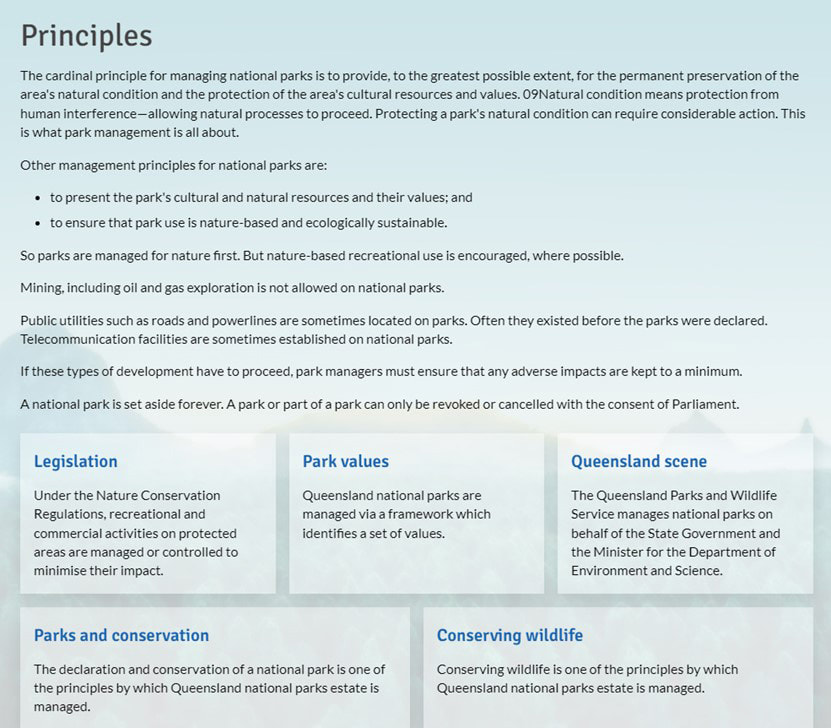
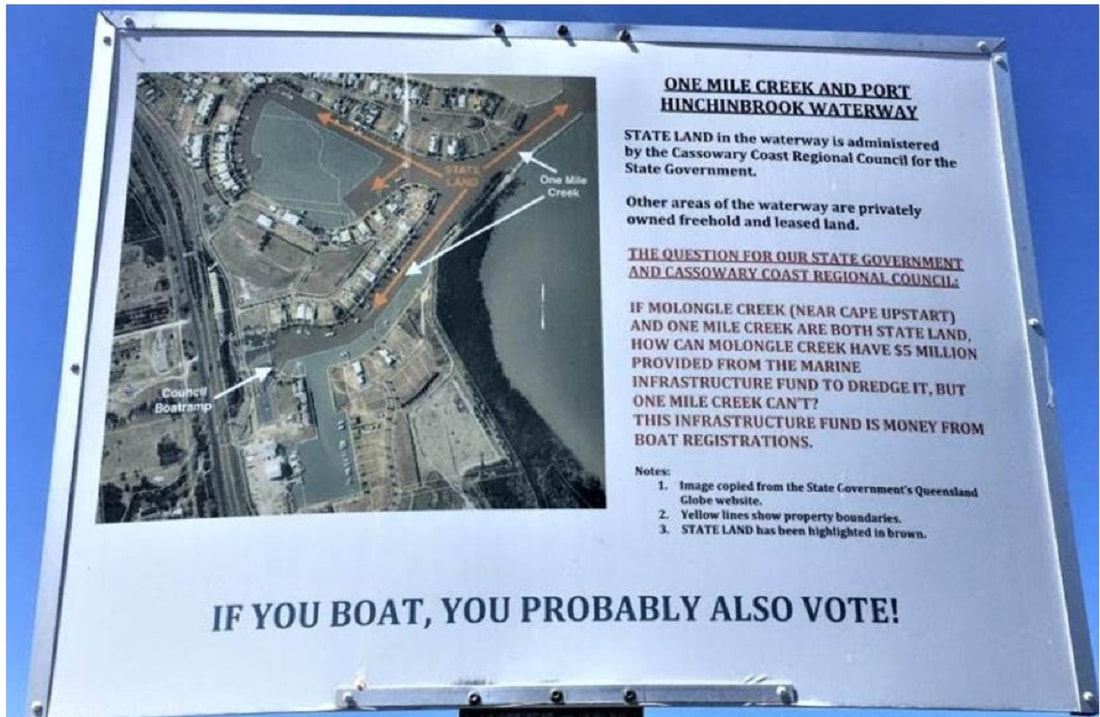







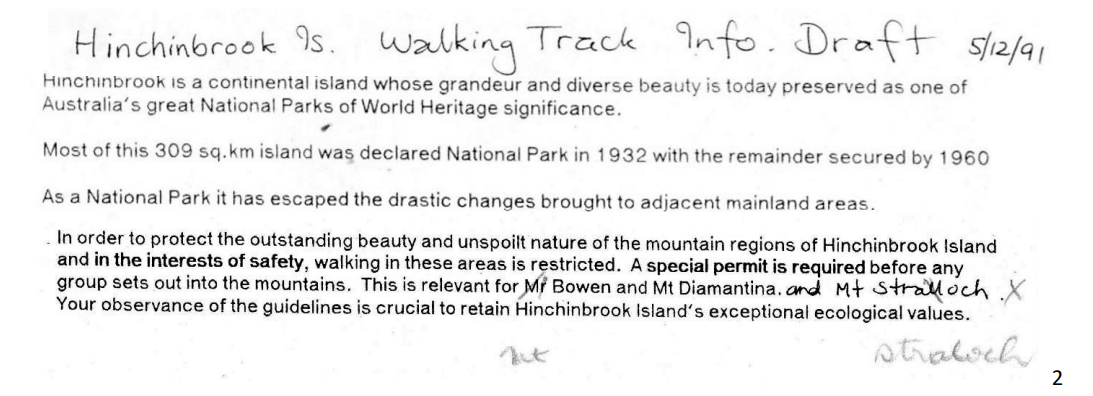
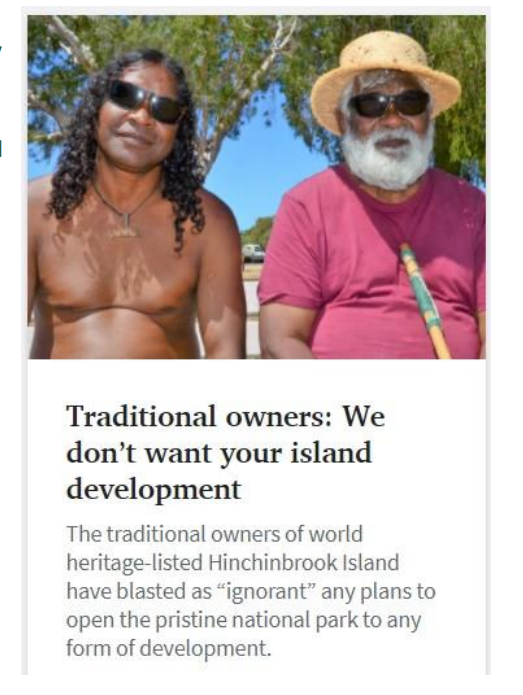
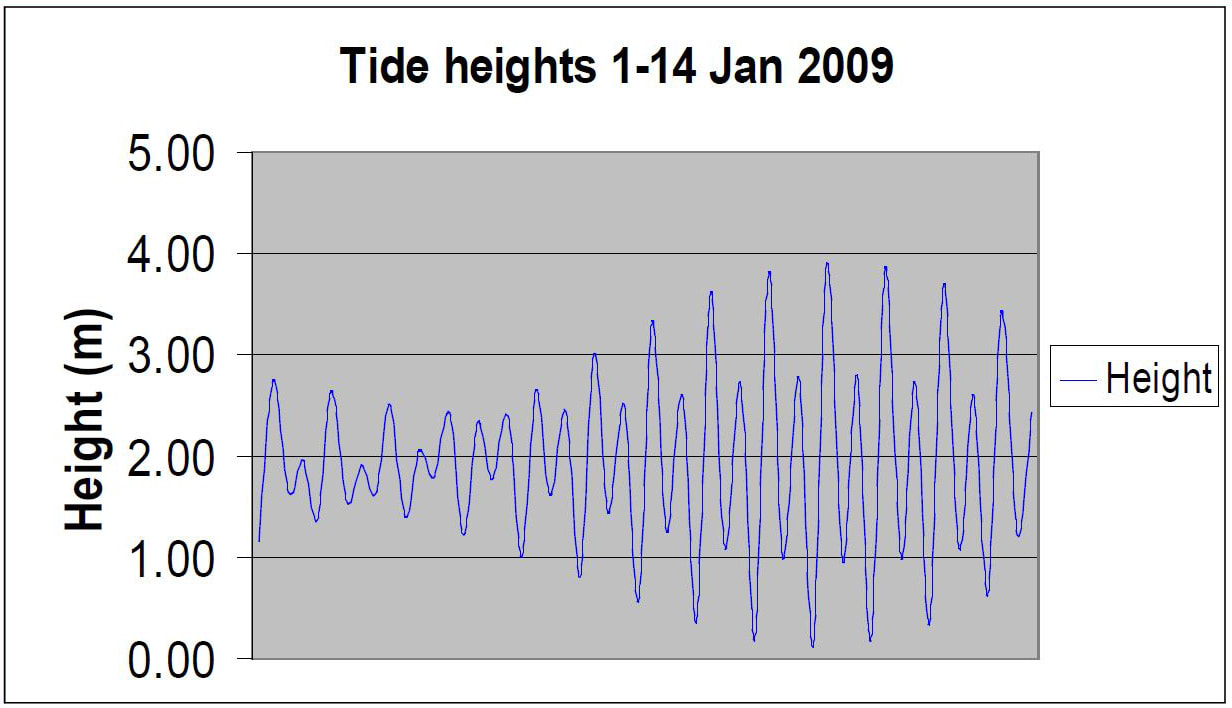















 RSS Feed
RSS Feed
